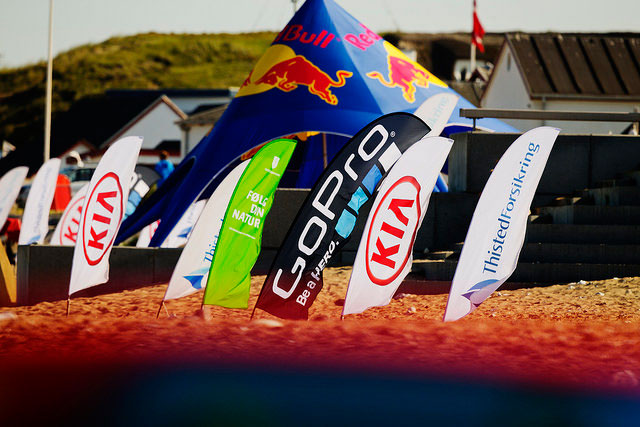How to Find a Sponsor for Your Sports Team or Sporting Event

In professional sports, sponsorship is a highly established practice.
We have all seen its presence in the brand names on the player’s uniforms, the ever-changing banners in the background, not to mention the advertising spots during, before and after the game.
Hell, often enough entire stadiums are named after corporate sponsors!
Yet, you don’t need to be at the top to get a sponsor for your team. Even people playing in lower leagues can find a sponsorship and in this article we will show you how.
Not only will you learn what sponsorship is and why it is a good idea but also practical ways to find a sponsor for your sports team or sporting event and close the deal.
This will be a lot to take in, so let’s get started.
What is Sponsorship and Why Get a Sponsor?

On the very basic level, sponsorship means getting help for your team in the form of money, goods and/or services.
Though it may sound a lot like donations, it is not. The main difference is that sponsorship is not a one way street but a mutually beneficial relationship between sponsor and recipient.
Let’s see what each party gets out of it.
Sponsorship Benefits for Your Team
What you, your team and club get out of having a sponsor is obvious: money, goods or other material help.
Sponsors will most often contribute financial means that can be invested in uniforms, travel costs, equipment or whatever else your needs are.
Sometimes a sponsor will also donate these materials directly, for example if they are a sporting goods store.
Other sponsors might donate refreshments for events or make their services available to you (e.g. a bus company who transports you to away games for free).
Sounds pretty sweet, right? However, having a sponsor is not only about getting things but also giving back. So, what’ in it for the sponsor (besides the warm fuzzy feelings of doing a good deed)?
Benefits for the Sponsor
For the sponsoring party, sponsorship is basically a marketing investment.
Sponsoring teams and events gives them positive exposure. This in turn can lead to increased sales, heightened brand awareness and customer loyalty.
Sponsorship is not just the domain of big business. Small and local shops can also use it as a marketing tool to improve their standing in the community.
By printing their logo on your jersey, displaying it on banners in the stadium, flyers or any other promotional material, they can show that they support your local team.
However, sponsorship also remains a marketing investment and therefore needs to be justified like any other expense.
Thankfully, sponsorship can be surprisingly cost effective and much cheaper than other campaigns.
However, it is up to you to show potential sponsors how a partnership with your team will help their business and that is exactly what we will talk about now.
How to Get a Sponsor for Your Team or Event
Now that we know why sponsorship is a good thing for both sides, let’s figure out how you can go about and get started.
Assign a Point Person
First, someone needs to take charge. Finding a corporate sponsor takes time and effort and it’s therefore best to have one person who takes the responsibility.
That doesn’t mean he or she has to do all the work, it can (and should) still be a team effort. However, it’s good to have one person who keeps the reins in hand.
When looking for a point person, keep in mind that sponsorship is mainly a business transaction and choosing someone with business or negotiation skills would be an asset.
Also, find a person who has the capacity to do the job well and isn’t burdened with a lot responsibility like the coaching staff.
Identify Your Needs and What You Can Offer
The first question to answer is what exactly do you need? Money for travel expenses? New uniforms? Transportation? Something completely different?
It’s easier to make a compelling case for sponsorship when you can tell companies exactly what their contribution will go toward.
To determine your team’s needs, it can help to have a meeting with all other players and club members to collect ideas and sort them by priority.
You probably already have some things in mind but it doesn’t hurt to brainstorm.

After that, it’s time to consider what you can offer sponsors in return for their investment.
For that, think first of their business goals and challenges and then what kind of real estate and possibilities you have for promoting your sponsor.
Here are some ideas:
- Their logo on your jersey (the classic)
- Banner at your home court, field, pool or wherever you play
- Logo and link on your website
- Include them on all printed materials
- Show their logo on your Facebook page
- Create a certain number of social media posts that include your sponsor
- Give them their own information booth at your sporting events
- Distribute sponsored giveaways
When thinking about what you can offer, it’s also important to remember that you have access to a highly targeted audience and demographic your sponsor might want access to.
Consider the people who are your fans and everyone else in your team’s circle of influence.
This includes people following you on social media. If you can boast large numbers of followers on Facebook, Pinterest or other platforms it will give you extra leverage.
Collect as much info on them as you can. The more you know about what kind of market access you have to offer, the more targeted you can make your approach.
Doing market research will help greatly with that.
Create Sponsorship Packages

Next up, it’s time to bundle your ideas into nicely packaged offers. By packaging your offers, it will show them exactly what type of benefits you can give them and for what price.
That way, it makes it easy for potential sponsors to choose what makes the most sense for their budget, business goals and time.
When calculating the costs, make sure the pricing scheme is based on solid numbers.
If you don’t know how much to ask for a particular package, it helps to think in impressions. Estimate how many people will likely see a sponsor’s message in a particular place.
This can be calculated from your average visitors at games, visits to your website, social media followers or newsletter recipients and will give you a starting point for your calculations.
(By the way, our SportsPress Pro plugin contains a sponsor feature that not only enables you to add sponsors to your WordPress site but also automatically tracks how many impressions and clicks they get. Just for your info.)
It’s also good to have such numbers to back up your request and show that you are serious and have done your homework.
Be aware that different kinds of impressions will be of different value for each sponsor. Adjust this accordingly when you contact them.
You can also offer extras like making one company the main sponsor of an event. Consider this in your pricing.
Businesses will likely have their own thoughts on what the sponsorship is worth to them and will negotiate but that’s part of the process.
Identify Potential Sponsors
Now it’s time to find people and businesses to approach.
As with everything, it’s best to start with those you have a direct connection with. As a first step you ask people in your club if their employers would be valid options and to introduce you to them.
Another good idea is to walk around the neighborhood of your club’s residence or use sites like Yelp to find local businesses.
However, don’t just approach anyone, it’s important to be strategic about it.
Make sure your values and the business’ values line up and that they have a vested interest in your sport, event, demographic or community.
For that, think about who could benefit from getting known in connection with your team. Businesses that are frequented by players, their families and other members of the community are an ideal target.
In addition to that, the type of businesses you approach are also worth considering.
For example, sporting goods stores might be more interested in sponsoring you than a business that is completely unrelated.
Furthermore, it also helps to research which companies have sponsored events or teams in the past and are therefore more likely to do it again.
Some large companies also have their own dedicated sponsorship programs (or budgets for corporate social responsibility) where you can apply online.
Make sure to look for those as well, especially with businesses that make sense for your sport.
Come up with at least ten valid potential businesses. Put them together in a database and start collecting their contact details.
For that, you can also make a first round of calls to the companies on your list and ask for the person responsible for sponsorships.
In larger companies, that will often be a marketing or advertising manager, in smaller businesses you might often have to talk to the general manager or owner.
While you are on the phone you can also directly find out if they do sponsorships at all and if so, what their goals are with it. This will help you tailor your messages more directly.
LinkedIn is another possibility to find people in charge.
Create and Send a Sponsorship Letter
After creating your sponsorship packages and finding suitable candidates, it’s time to create a letter or email template.
While a blueprint that can be reused for different businesses is useful, you should tailor each letter to the specific sponsor you send it to.
A rough template could look like this:
- Introduction — Introduce yourself, your team, club or event. Tell your story, describe what you do and why you seek sponsorship.
- Show your potential — Talk about the size and makeup of your audience and the possibilities for sponsors. If you already had a sponsor in the past, mention them and what they got out of working with you.
- Talk about them — State why you approached this particular company. Show that you have done your homework and that you have developed an idea how you could help them, e.g. that you have a lot of overlap in audience.
- Deliver the sell — Directly ask for sponsorship while clearly stating the business benefits for the other side. Lay out your different (tailored) sponsorship packages so they can weigh their options and make a choice. State that you’d be happy to go over the specifics with them.
- Call to action — Finally, ask them to get in touch with you, fill out a form or do whatever you want them to. Don’t forget to give your contact details. It’s best to give both a phone number, an email address and a mailing address. You can also include your team website. And don’t forget to thank them for their time!
As you can see, the idea is to approach this as the beginning of a mutually beneficial and long-term relationship.
Of course it goes without saying that you should strive for professionalism in order to present yourself as worthy of sponsorship.
When you are finished, it’s time to send out the letters. Better yet, deliver them in person as it’s much more personal and makes a big impression.
Follow Up
It might take a while for potential sponsors to get back to you, so don’t expect to hear from them the very next day after you send the letter.
However, if you haven’t heard back within a week, don’t hesitate to follow up, preferably by phone.
Be polite but straightforward, ask about your proposal, what their thoughts are and if there is anything they need clarified.
If they decline, it’s good to ask for feedback and their reasons. While everyone might not be open about their reasons, it’s definitely worth asking to give you insight and valuable information for the next round of sponsor outreach.
If they are interested, great! Time to set up a meeting and make things official.
Come to an Agreement

If someone shows serious interest in sponsoring your team, it’s a good idea to develop a written agreement on the terms of the sponsorship.
Because there still might be some details to negotiate and hammer out, it’s best to set up a meeting face to face though talking on the phone can also be acceptable.
When you write up the agreement, make sure it specifically states what each party is promising to do in the partnership. Work on it until both sides are satisfied with a mutual agreement.
After that, all that is left is the signature. Congrats, you just signed your first sponsor!
Do Your Due Diligence
However, much of the real work begins after your sign the sponsorship agreement. From that point on, your responsibility is to take the agreement seriously and commit to do everything you promised.
Your sponsors have put their trust in you (and their money) and it’s only fair that you do your part.
In fact, it’s a good idea to do your darndest to make it worth your sponsor’s while and go above and beyond what they expect.
That way, you make it more likely that they will be a “repeat customer” and are happy to continue the sponsorship.
For example, you might send them proof of the placement of their logos in the form of screenshots and photos. Even if you have not agreed to do so, they will surely appreciate it.
With the aforementioned SportsPress Pro sponsors module you can even tell them exactly how many people have seen their logo and have clicked on it!
Also, don’t hesitate to invite your sponsors out to games and other events. By going to extra mile, you’ll find that your sponsors will be happy to support you again next year.
Ready to Get a Sponsor?
Sponsorship is not only for the top teams of the world. Amateur and semi-professional teams can also benefit from working with a sponsor.
Supporters can help finance travel, new equipment and other investments while they themselves benefit from the positive exposure and boost to their business.
If you can offer sponsors real-life benefits, finding them is far from impossible. Especially local businesses are often more than happy to help you out.
The process above teaches you in detail how to figure out what you can offer to potential sponsors as well as how to find and approach them.
Don’t be afraid to put yourself out there and reach out to potential sponsors. With some creativity and determination you too can get a sponsor for your sports team.
Want to build a sports team website potential sponsors can’t help but be impressed by? Try out SportsPress our free WordPress plugin that makes it as easy as pie. We also offer themes for many different types of sports. And if you have questions, please don’t hesitate to get in touch.
Image credits: Cold Hawaii, Luigi Mengato, Kim Eriksson, Flazingo Photos
